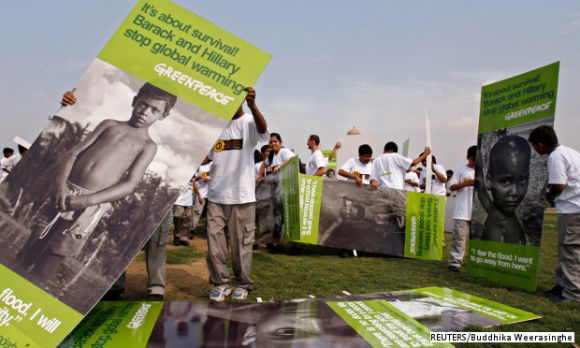Articles features
Why Greenpeace is first on the chopping block

New Delhi, May 13
As Greenpeace India struggles to
stay afloat, the real reason why the government wants to shut down the
global environmental NGO hasn’t got much attention: Coal, the single
biggest source of primary energy in India, is at the heart of the
Narendra Modi government’s ambitious plans to ramp up industrial
production in the country.
A total of 1,199 new coal-based
thermal power plants with a total installed capacity of more than 1.4
million MW are proposed worldwide, the lion’s share — 455 plants — being
in India, according to data from the World Resources Institute.
India
is overwhelmingly dependent on fossil fuels — coal, oil and gas — which
meet more than three-fourths of the country’s energy needs, despite
Modi’s plans to promotealternative energy sources.
Of
the fossil fuels, oil and gas account for just about 30 percent of
India’s energy needs, the bulk imported (80 percentin the case of crude
oil). India has abundant reserves of coal, the fourth-largest in the
world.
Coal meets 54.5 percent of India’s energy needs and 61.5
percent of the installed power generation capacity, and plays a key role
in industries like steel and cement.
India is set to
more than double its coal consumption by 2035 and become the world’s
largest coal importer by around 2020, according to the International
Energy Agency.
The cheapest of fossil fuels, coal is
also the most polluting in terms of carbon emissions. Coal-burning power
plants are the single biggest cause of climate change, way ahead of the
burning of petroleum in transportation.
Greenpeace has
been at the forefront of a global campaign against coal mining and
burning, and its Indian wing has mounted several high-visibility
campaigns against coal-burning thermal power plants and coal mining in
forest areas.
Coal India and Adani in the spotlight
Especially
irksome to the government must have been Greenpeace’s targeting of two
domestic entities that are also major global players in coal — the
public-sector Coal India, India’s fifth most valuable company by market
capitalisation at $35.9 billion (Rs.2.3 lakh crore) and the
Gujarat-based Adani Group, whose promoter Gautam Adani is known to have a
close relationship with Modi.
Coal India is number one and the
Adani Group number three on the list of the top 200 coal companies
globally ranked by the potential carbon emissions content of their
reported reserves, according to Fossil Free Indexes, a stock market
index that promotes ethical investing.
Greenpeace
has campaigned against both companies, exposing their claims on reserves
and financial health, and documenting environmental and other
violations. Greenpeace’s Australia chapter has opposed Adani’s plans to
develop the world’s largest coal deposit, the Carmichael mine in
Queensland, which it acquired for $16.5 billion dollars.
Breakneck industrialisation, Chinese style
Companies
like Coal India and Adani are expected to play a vital role in the Modi
government’s grand plan for India to take over from China as the new
‘factory of the world’.
With GDP growth dipping to seven
percent for the first quarter of 2015 (the lowest since 2009), China is
clearly slowing down. India seems intent on capitalising on this
slowdown and the newfound limits on growth imposed by environmental and
health concerns in China.
The first signs that the Modi
government is pushing for a Chinese-style industrialisation project came
when it announced a clutch of mega projects under the Make in India
initiative. Work is underway on the most ambitious of these projects,
the Delhi-Mumbai Industrial Corridor, across six states, to be built at
an estimated cost of $100 billion.
For the government,
one of the chief obstacles in this path is land acquisition, which is
being tackled through amendments to the existing legislation. The other
big hurdle is energy, in which coal will continue to play the biggest
part – and this is at the core of its grouse with organisations such as
Greenpeace.
Coal and Climate Change–an existential threat
The
burning of fossil fuels — coal, oil and gas, in that order — releases
massive amounts of carbon into the atmosphere, and has been proven to be
the biggest culprit behind climate change.
With
carbon-dioxide levels at record highs—asIndiaSpend reported — only a
fraction of the known extractable fossil fuel reserves, least of all,
coal, can be burned without endangering the world’s future, the reason
why campaigners like Greenpeace are dead set against the fuel.
But
for the Modi government, and India’s elites and middle classes in
general, this would amount to the big prize being snatched away from
sniffing distance. That’s why the shots fired against Greenpeace may be
only the first in the long, bruising battle ahead.
(In
arrangement with IndiaSpend.org, a data-driven, non-profit,
public-interest journalism platform. (Sajai Jose is a freelance media
professional based in Bengaluru. The views expressed are personal)



































